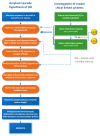Chiral Linked Systems as a Model for Understanding D-Amino Acids Influence on the Structure and Properties of Amyloid Peptides
- PMID: 35328481
- PMCID: PMC8955658
- DOI: 10.3390/ijms23063060
Chiral Linked Systems as a Model for Understanding D-Amino Acids Influence on the Structure and Properties of Amyloid Peptides
Abstract
In this review, we provide an illustration of the idea discussed in the literature of using model compounds to study the effect of substitution of L- for D-amino acid residues in amyloid peptides. The need for modeling is due to the inability to study highly disordered peptides by traditional methods (high-field NMR, X-ray). At the same time, the appearance of such peptides, where L-amino acids are partially replaced by D-analogs is one of the main causes of Alzheimer's disease. The review presents examples of the use diastereomers with L-/D-tryptophan in model process-photoinduced electron transfer (ET) for studying differences in reactivity and structure of systems with L- and D-optical isomers. The combined application of spin effects, including those calculated using the original theory, fluorescence techniques and molecular modeling has demonstrated a real difference in the structure and efficiency of ET in diastereomers with L-/D-tryptophan residues. In addition, the review compared the factors governing chiral inversion in model metallopeptides and Aβ42 amyloid.
Keywords: D-amino acids; amyloid peptides; chiral inversion; chiral linked systems; diastereomers; electron transfer; fluorescence quenching; molecular dynamics; spin effects.
Conflict of interest statement
The authors declare no conflict of interest.
Figures












Similar articles
-
Photoinduced Processes in Lysine-Tryptophan-Lysine Tripeptide with L and D Tryptophan.Int J Mol Sci. 2023 Feb 7;24(4):3331. doi: 10.3390/ijms24043331. Int J Mol Sci. 2023. PMID: 36834744 Free PMC article.
-
Role of Chiral Configuration in the Photoinduced Interaction of D- and L-Tryptophan with Optical Isomers of Ketoprofen in Linked Systems.Int J Mol Sci. 2021 Jun 8;22(12):6198. doi: 10.3390/ijms22126198. Int J Mol Sci. 2021. PMID: 34201293 Free PMC article.
-
Optical Configuration Effect on the Structure and Reactivity of Diastereomers Revealed by Spin Effects and Molecular Dynamics Calculations.Int J Mol Sci. 2021 Dec 21;23(1):38. doi: 10.3390/ijms23010038. Int J Mol Sci. 2021. PMID: 35008460 Free PMC article.
-
Marfey's reagent for chiral amino acid analysis: a review.Amino Acids. 2004 Dec;27(3-4):231-47. doi: 10.1007/s00726-004-0118-0. Epub 2004 Oct 22. Amino Acids. 2004. PMID: 15503232 Review.
-
Biological implications of oxidation and unidirectional chiral inversion of D-amino acids.Curr Drug Metab. 2012 Mar;13(3):321-31. doi: 10.2174/138920012799320392. Curr Drug Metab. 2012. PMID: 22304623 Review.
Cited by
-
Peptide Inhibitors of Insulin Fibrillation: Current and Future Challenges.Int J Mol Sci. 2023 Jan 9;24(2):1306. doi: 10.3390/ijms24021306. Int J Mol Sci. 2023. PMID: 36674821 Free PMC article. Review.
-
Impact of Non-Covalent Interactions of Chiral Linked Systems in Solution on Photoinduced Electron Transfer Efficiency.Int J Mol Sci. 2023 May 26;24(11):9296. doi: 10.3390/ijms24119296. Int J Mol Sci. 2023. PMID: 37298248 Free PMC article.
-
Stereoselectivity of Interaction of Nonsteroidal Anti-Inflammatory Drug S-Ketoprofen with L/D-Tryptophan in Phospholipid Membranes.Membranes (Basel). 2022 Apr 24;12(5):460. doi: 10.3390/membranes12050460. Membranes (Basel). 2022. PMID: 35629787 Free PMC article.
-
Photoinduced Processes in Lysine-Tryptophan-Lysine Tripeptide with L and D Tryptophan.Int J Mol Sci. 2023 Feb 7;24(4):3331. doi: 10.3390/ijms24043331. Int J Mol Sci. 2023. PMID: 36834744 Free PMC article.
References
-
- Tverdislov V.A., Yakovenko L.V., Zhavoronkov A.A. Chirality as a problem of biochemical physics. Russ. J. Gen. Chem. 2007;77:1994–2005. doi: 10.1134/S1070363207110291. - DOI
Publication types
MeSH terms
Substances
Grants and funding
LinkOut - more resources
Full Text Sources

